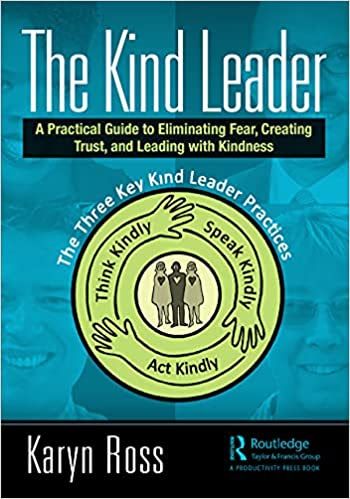
The Kind Leader - Karyn Ross
If you want to be a beloved and respected leader, you must have courage and be kind. Learn here the benefits of the kind leadership.
Add to Favorites
Add to read
Mark as read
You may know the story of Cinderella. This Disney's fairy tale is a story of jealousy, virtues and sufferings of Cinderella and hostility of her older sisters.
It has won over many generations and everyone who believes that a humiliated being will rise and win and also that kindness and virtue not only have to be rewarded but also recognized.
It may seem like just another cliché fairy tale, but it makes a lot of sense. Anthropology says that the human being is a reciprocal being, that is, we return in equal proportion what is given to us.
In "The Kind Leader," you will see how reciprocity creates strong leaders who can and should be kind. Are you ready to discover the power of kind leadership? Then let's go!
About the book "The Kind Leader: A Practical Guide to Eliminating Fear, Creating Trust, and Leading with Kindness"
The book "The Kind Leader: A Practical Guide to Eliminating Fear, Creating Trust, and Leading with Kindness" was published on September 10, 2021 by Productivity Press.
The book has 206 pages divided into 8 main chapters. In them, the author Karyn Ross challenges the reader to rethink their ideas about the concepts such as leadership, kindness, and kind leadership.
In addition, each chapter presents case studies and reflections of leaders and the people they influence.
About the author Karyn Ross
Karyn Ross is the founder of The Love and Kindness Project Foundation and The New School for Kind Leaders. In addition, she is the co-founder of Women in Lean - Our Table.
Karyn Ross is not only a visual artist, but also has charted an impressive career as an internationally acclaimed speaker, award-winning author, consultant, and coach.
In addition to having published five other books, Karyn travels the world teaching people her unique system of combining creativity, continuous improvement, and kindness to make a better world.
To whom is this book indicated?
"The Kind Leader" is recommended for leaders or people who seek leadership positions, but feel the need for significant improvements in the relationships with their teams, increasing the organization's unity and synergy.
Main ideas of the book "The Kind Leader: A Practical Guide to Eliminating Fear, Creating Trust, and Leading with Kindness"
- Leaders lead other people, but it is kindness that connects leaders and followers through positive actions;
- Your thoughts, ideas, assumptions, and actions about leadership and kindness are based on models you have learned about in many ways;
- Kind leadership starts with you;
- A leader's actions create culture, kind or not;
- Leadership is not just "results-oriented."
- Kind leadership practices also create new opportunities for relationships and role models.
Download the "The Kind Leader" Book Summary in PDF for free
Do you have no time to read now? Then download the free PDF and read wherever and whenever you want:
Isn't kindness a sign of weakness?
Isn't leadership about 'strength'? About making tough decisions and having the fortitude to carry those decisions out no matter how difficult they are? And what about kindness? Don't kind people get walked all over? If leaders are too kind, how will they be able to make those inevitably tough decisions when the time comes?
Isn't kindness a type of weakness?
Assumptions, Systems and Models
Kindness is not a sign of weakness. It is a sign of confidence. - Colin Powell
No, kindness is not a sign of weakness! We are used to the idea that it is weakness because we believe that there are only two options: to be loved or to be respected.
Assumptions like this arise from systems and models that shape our society and our conceptions about certain "concepts". For example, what is leadership for you? What about kindness, empathy, compassion?
See how Karyn Ross defines each one of them:
- Leadership: It is when leaders lead other people;
- Leader: Is a person that someone is, temporarily, following;
- Follower: Is a person who has decided to pay attention, take their cues on how to act, react, and have their thoughts, words, and actions influenced by a person they consider a "leader";
- Kindness: It is an action (or set of actions), connecting a person's internal feelings of empathy and compassion to others that is undertaken with the purpose of generating a positive effect and outcome for another;
- Empathy: It is the ability to sense other people's emotions, coupled with the ability to imagine what someone else might be thinking or feeling;
- Compassion: It is what connects the feeling of empathy to acts of kindness, generosity, and other expressions of altruistic tendencies.
The Five Key Characteristics of a Kind Leader
This is likely not how you would define a leader or leadership. It may be a wrong assumption, but perhaps you thought of more complex concepts or successful people. More specifically, dare we say, you thought of men like Elon Musk rather than women like Malala.
Unfortunately, the model of leadership where a man is always the leader leads to the assumption that leadership and kindness are not compatible because leadership is associated with strength and kindness with weakness.
And men are not kind, they are strong - which makes them natural born leaders. Women, however, are always kind, so we don't think of them when we talk about leadership.
But while kindness is often thought of as a weakness, it takes a lot of strength to consider the needs of others. So it is not your gender that defines your leadership ability or your strength, but your ability to consider needs other than your own.
Therefore, Karyn Ross defines the five characteristics of the kind leader:
- Kind Leaders actively model kind behavior;
- Kind Leaders deliberately think, speak and act kindly;
- Kind Leaders consider others first;
- Kind Leaders reflect deeply about their actions;
- Kind Leaders focus on the means.
The ends are as important as the means
You may have heard about Machiavelli's "The Prince" or perhaps the quote "the ends justify the means"? Despite its fame, Machiavelli never explicitly said this, but he implied that the prince (or leader) should pursue his goals at any cost, no matter what will be done.
But, it is important to point out that the main goal should be the common good. Therefore, the ends are as important as the means for a kind leader. The Machiavelian maxim that it is much safer to be feared than loved does not work with kind leaders.
Do you know why? Because they focus on the means and are not just "results oriented". They focus on the means and on creating a kind culture so that the people who do the work to create those results can flourish.
Focusing on the means ensures great results for everyone.
The Triads of the Kind Leadership
Thoughts create the words you speak and influence your actions and practices. Therefore, gentle leadership has two triads: the triad of practices and the triad of general behaviors.
The triad of practices, where each practice has its own behavioral triad, is composed as follows:
- Think kindly;
- Speak kindly;
- Act kindly.
The general behavioral triad, on the other hand, is composed as follows:
- Assume Positive Intent;
- Check your thoughts frequently;
- Think in a kind way rather than in an unkind way.
Collaboration, Cooperation and Kindness, not competition
For Karyn Ross, one of the best things about kind leadership is that when leaders act, react, and lead kindly, the result is more kindness from their followers, who imitate these behaviors in a variety of situations.
The practical consequence is the Kind Leadership Continuum. As they spread, kind leadership practices also lead to better ways for people and groups to interact together within organizations, in communities, in society at large, and around the world.
For the author there are 4 types of interaction:
- Competition (win-lose interactions): Based on division into two opposing sides and feelings of fear and distrust;
- Collaboration (interactions based on 'Buy-in'): The two sides commit to work together, but still have separate interests and use principles like Buy-in and Opt-Out;
- Cooperation (win-win interactions): Based on the idea of two sides acting together, but seeking particular mutual benefits.
- Kindness (Interactions beyond Win-Win): There is harmony and connection between the parties, as they become a unit that works as a single party.
But, life is no bed of roses...
And, many times, we end up being rude. Believe, this will happen because people are people.
As human beings, people have biases and negativity to spare, so it's hard not to engage in unkind ways of acting, reacting, and interacting with others.
Stay tuned for the top three reasons that cause insensitive leadership:
- Organizational systems in general promote competition and a culture of fear;
- The leaders of most organizations do not set clear definitions and standards for kind actions, reactions, and interactions;
- The organization's leader is not modeling kind behavior on their own, which ties into the first reason.
So what would be the solution to such a problem? Karyn Ross teaches you 5:
- Be Positive: Take a deep breath and check your thoughts;
- Stop and Listen: Observe and listen without prejudice, have an open mind and heart;
- Focus on the Means: Locate the interactions in The Kind Leadership Continuum;
- Help Others: Actively help people to act, react and interact more kindly;
- Reflect on your Practice: Deepen your practice to help others continue to deepen theirs.
What do other authors say about it?
In "Everyone Matters" by Bob Chapman and Raj Sisodia, the ideals that should guide an organization that values people first and foremost are presented. In addition, this reading will bring an account of how a "humanized" company works in practice, using examples experienced in Chapman's company.
The book "Firms of Endearment", by Raj Sisodia, Jag Sheth, and David B. Wolfe, also addresses the idea of a "humanized" company and the fundamentals and practices adopted in this humanization process, thus demonstrating the way to transform your organization in the long term.
Finally, the book "O Melhor do Cortella", by Mário Sérgio Cortella, serves as a guide to make you reflect on our existence and our society and how assumptions, systems and models shape the world.
Okay, but how can I apply this to my life?
- Lead in an emotionally intelligent way;
- Be empathetic and compassionate;
- Instead of criticizing, help the person to improve;
- Be alert to the impact your words can have on the other person;
- Encourage and train your team to be kind.
Did you like this summary of the book "The Kind Leader: A Practical Guide to Eliminating Fear, Creating Trust, and Leading with Kindness"?
So, do you still think that leadership and kindness don't go hand-in-hand? Leave your opinion in the comments, your feedback is very important to us!
Also, you can get access to the full book by clicking on the image below to buy it:

![Click and download the PDF! [Book Summary] The Kind Leader - Karyn Ross](https://images.prismic.io/pb4y/ODI0MmEzNjAtY2E2Zi00MWYxLWE0NjUtYzg0NzY0NTYwMTQ2_0pikt82sloraxnrswcbhkhi95gj2tieaipv1d6krkdy2ftneeslclmud7ssejc6crxngjq3pmpmm4lbm_kjdiljxmpfdrsvfzo5hfjralmfu-edsf_d0qcjpzbqdqnt-4msgqyoo)
